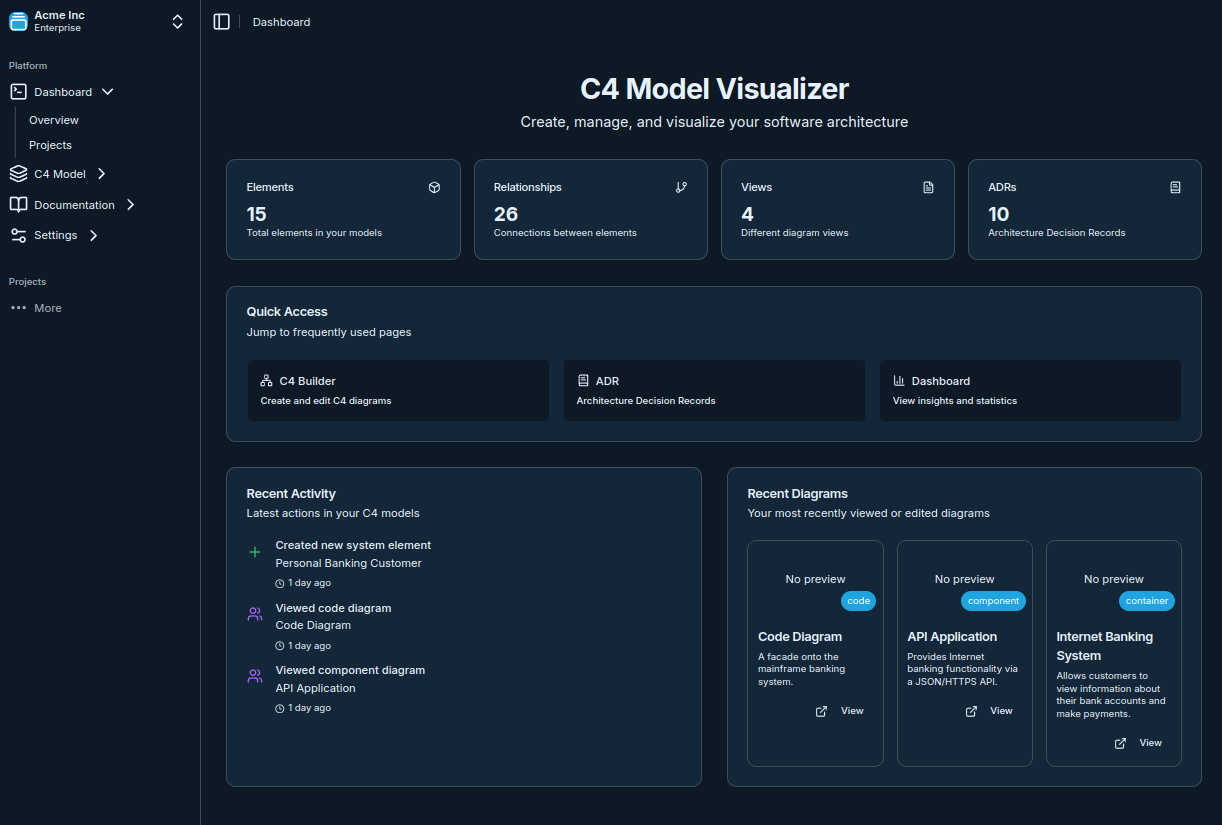Centralizing Your Architecture - The Power of a Unified Repository for C4 Models and ADRs
Welcome to our guide on centralizing your architecture documentation! This article explores how Visual C4's unified repository for C4 models and Architecture Decision Records (ADRs) can transform your architecture management process.
The Challenge of Fragmented Architecture Documentation
In many organizations, architecture documentation is scattered across various tools, wikis, and repositories. This fragmentation creates several problems:
- Knowledge silos where critical information is inaccessible to team members
- Inconsistent documentation that quickly becomes outdated
- Disconnected artifacts where diagrams and decisions exist in isolation
- Difficult onboarding for new team members trying to understand the system
The Power of Unification
A centralized architecture repository that combines C4 model diagrams with Architecture Decision Records creates a powerful synergy:

Key Benefits
- Complete Context: Link architectural decisions directly to the components they affect
- Enhanced Traceability: Trace how decisions have shaped your architecture over time
- Improved Governance: Ensure architectural compliance through clear documentation
- Streamlined Collaboration: Enable teams to work together with a single source of truth
- Efficient Onboarding: Help new team members quickly understand both the "what" and "why" of your architecture
Essential Features of Visual C4's Unified Repository
Visual C4's architecture repository includes:
For C4 Model Diagrams
- Support for all four C4 levels (Context, Container, Component, Code)
- Consistent notation and styling
- Version control for tracking changes
- Ability to link between different levels of abstraction
For Architecture Decision Records
- Structured templates for consistent documentation
- Status tracking (proposed, accepted, deprecated, etc.)
- Categorization and tagging for easy reference
- Chronological history of decisions
For Integration
- Direct linking between ADRs and diagram elements
- Unified search across all documentation
- Collaborative features like comments and notifications
- Export capabilities for presentations and reports
Implementation Strategies
Implementing Visual C4 as your unified repository requires a simple approach:
- Assess Current State: Inventory existing documentation and identify gaps
- Migrate Existing Documentation: Consolidate documentation into Visual C4
- Establish Standards: Define templates, processes, and governance rules
- Train Teams: Ensure everyone understands how to use and contribute to the repository
Real-World Impact
Organizations that have implemented unified architecture repositories like Visual C4 report:
- reduction in time spent searching for architecture information
- improvement in architecture decision quality
- faster onboarding for new team members
- better alignment between development teams and architecture
Explore Related Topics
- Documenting Architecture Decision Records
- Mastering C4 Model Architecture
- Team-Based Architecture Collaboration
Getting Started with Unified Documentation
Ready to implement a centralized architecture repository? Begin with these essential practices:
- C4 Model Tutorial - Master the fundamentals of C4 modeling before centralizing your diagrams
- Architecture Decision Records - Learn effective ADR templates and tools for your unified repository
- Linking ADRs with C4 Models - Discover specific techniques for connecting decisions with visual models
Scaling Your Implementation
For organizations implementing unified repositories across multiple teams:
- C4 Context Diagram Guide - Establish consistent system boundary documentation practices
- Future of Architecture Modeling - Plan for evolving tooling and integration capabilities
Conclusion
Visual C4's unified repository for C4 models and ADRs is more than just a documentation solution—it's a strategic asset that enhances architecture governance, improves team collaboration, and ensures your architecture evolves in a controlled and intentional way.
By centralizing your architecture documentation with Visual C4, you create a single source of truth that captures both the structure of your systems and the reasoning behind key decisions, providing invaluable context for current and future team members.